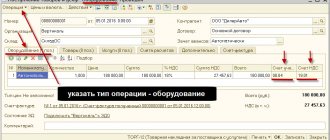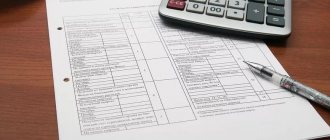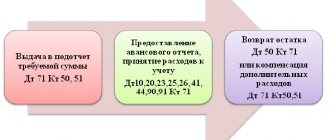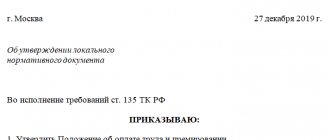Scope of application
Every enterprise employs people who receive wages and other benefits for their work. In order to keep records of funds issued, on the basis of Order of the Ministry of Finance No. 94n dated October 31, 2000, all settlements with personnel for wages are attributed to account 70 in the accounting department. It also groups data on the payment of bonuses, compensation, benefits, dividends on shares, and income from securities.
Card
The credit balance on account 70 means the company's debt to employees. Therefore, at the end of the reporting period it is necessary to calculate it and include the amount in the liability item of the balance sheet.
Note! It is possible to record not only by each employee, but also by type of transaction: payroll, benefits, compensation, deductions, etc.
Account characteristics
To record payroll calculations, account 70 is used. When asked which account 70 is active or passive, you can clearly answer that it is an active-passive account.
Depending on the situation, it can have two balances at once. The debit balance reflects the debt of persons working at the enterprise for the wages paid to them by the enterprise. The loan balance, on the contrary, reflects the employer’s debt to the employees working in the company.
When determining the final account balance, it matters which side the balance is on. If by debit, then the debit turnover reflects the increase in debt, and the credit turnover reflects its repayment.
The opening balance is added to the debit turnover, after which the resulting result must be compared with the credit balance. If the final value of the difference with the loan turnover turns out to be positive, then the final balance is a debit.
When the initial balance of account 70 is on credit, then the increase in debt is reflected on the credit side, and its repayment on the debit side. If the difference between the amount of the opening balance and the turnover on the credit account with the debit turnover is positive, then the ending balance is in credit. Otherwise, at the end of the period, a debit balance of account 70 is obtained.
Attention! The turnover sheet for account 70 can reflect two balances at once. This is due to the fact that subaccounts within it can be either debit or credit, and the synthetic account has a folded double balance.
In the balance sheet, account 70 balances are reflected as follows:
- In the asset as part of current assets on line 1230 as accounts receivable.
- In liabilities as part of short-term liabilities on line 1520 as accounts payable.
You might be interested in:
Accounting for the receipt of fixed assets in the organization, their cost, accounting entries
Characteristics
To obtain reliable information about payments, analytical records are maintained for each employee of the enterprise. To see the total amount of accruals, you can create a balance sheet. It will show all payments made, deductions, as well as the company’s possible debt to employees. In addition, it is used for:
- formation of payment and settlement statements;
- creating a journal order;
- employee income cards;
Analysis of account 70 is used when preparing reports on personal income tax and insurance premiums.
To answer question 70, is the account active or passive, you need to look at how income and expenses are distributed over it. Debit 70 of the account shows the expenses incurred: salaries paid, bonuses, benefits, as well as alimony, personal income tax, and fines withheld from employees. The loan is used to accrue amounts due to employees.
According to the characteristics of account 70, debit shows the debt of employees, credit shows accrued but not paid amounts. Usually it has a credit balance, because salaries are accrued until the end of the current month and paid only in the next month. Thus, in accounting it is passive.
Important! For the convenience of accounting, an account card 70 is created. This register allows the accountant to avoid possible errors in accounting and timely track all transactions performed in the context of calculating wages to employees.
Count 70 – active or passive?
To understand whether the 70 account is active or passive, let’s look at its structure. To do this, let's see how the revolutions increase and decrease. Counting scheme 70:
| Opening balance | |
| Debit | Credit |
| Various deductions and the fact of payment of income (salaries, vacation pay, bonuses, benefits, etc.) are reflected. | Accruals of salaries and other types of income are reflected |
| Opening balance |
From the above figure it is clear that credit 70 of the account shows the accrual of amounts of wages, benefits and other income in correspondence with accounts - , , 20, , , 29, 28, , 96, etc. And debit 70 of the account shows the amount of salaries already paid , salaries, benefits, bonuses, allowances, as well as the amount of deductions in terms of personal income tax, alimony, loans, etc. In this case, the correspondence of account 70 depends on the type of deduction and the method of issuing funds - , , , 52, 69, , , , 71, , 79.
Therefore, count. 70 is passive, meaning it usually has a credit balance. In this case, the debit of account 70 means the debt of the employee, and the credit means the debt of the enterprise.
What are the subaccounts?
Each employee of the company creates his own sub-account, which will account for all accruals, payments and deductions for the entire period of his work in the organization. For ease of work, they are combined by department and divided into the following groups:
- payments to employees included in the company's staff;
- payments to employees with whom a contract has been concluded;
- payments to employees working part-time;
- payments to employees with a confirmed disability group.
Each organization itself has the right to create and approve the analytics it needs, but taking into account the requirements of Order of the Ministry of Finance No. 94n dated October 31, 2000.
The following subaccounts are most common at enterprises of different levels:
- 70.1 - used for payroll;
- 70.2 - serves to reflect deposited amounts;
- 70.3 - salary debts are reflected;
- 70.4 - shows the amounts to be issued;
- 70.5 - amounts transferred to deposits are entered;
- 70.6 - reflects the rounding amounts used when calculating wages.
What does account credit 70 show: salary postings
Payroll in an organization includes, in fact, the only group of operations that are shown in account 70 - those related to the payroll itself on the basis of employment or civil contracts (vacation pay, sick pay at the expense of the employer).
Salary accrual is shown by posting Dt 20 (23, 25, 26, 44...) Kt 70. On account 70, the liability increases - by the amount of the obligation to pay wages. An asset increases in the expense account—in the form of payroll expenses.
The posting amount corresponds to the total amount of wages including personal income tax. This is due to the fact that de jure tax is paid on the income of the employee himself. Personal income tax may not be charged if the employee receives a tax deduction during the billing period.
The following accounts can be used to account for labor costs:
- 08 (if wages are accrued to employees involved in the construction (creation) of an OS facility);
- 23 (if calculations are carried out at auxiliary production);
- 25 (if salaries are paid to employees of service departments);
- 26 (if salaries are paid to management and managers);
- 44 (if the salary is paid to the sales department or in a trading company);
- 96 (if vacation pay is paid from the reserve).
Note that transactions related to the calculation of insurance premiums are not shown in account 70, despite the fact that the very fact of calculating these contributions is associated with the payment of wages. The fact is that the employer pays the contributions de jure at his own expense, without deducting them from the employee’s salary itself.
Basic entries for contributions:
Don't know your rights? Subscribe to the People's Adviser newsletter. Free, minute to read, once a week.
- Dt 20 (23.25...) Kt 69 (contributions accrued);
- Dt 69 Kt 51 (contributions transferred to the budget).
In this case, correspondence between accounts 70 and 69 is possible. For example, if there is a payment of sick leave on account of subsequent compensation from the Social Insurance Fund, then this is shown by posting Dt 69 Kt 70.
Now let's look at the postings to account 70 by debit.
How debits and credits are displayed
The debit includes paid amounts of bonuses, wages, benefits, accrued taxes, as well as deductions under writs of execution, income from participation in the capital of the company, and others. If the accrued amount is not paid to the employee on time, then it begins to be reflected in the debit of account 70 “Settlements with personnel for wages” and in the credit of account 76 “Settlements with various debtors and creditors.”
Debit
Corresponds by debit with the accounts:
- related to cash accounting;
- taking into account settlement transactions. These include 66-69, 73, 76 and 79;
- employees for the formation of financial results 90, 91, 93, 94.
All debit movements mean reducing the company's debt to employees or collecting amounts for taxes or fines.
The following amounts are included in the credit of account 70:
- Payments assigned to employees in correspondence with the accounts of production costs or sales expenses, depending on the activities of the organization.
- Remuneration generated from the reserve for vacation pay and remuneration for long service, if this is provided for at the enterprise. This payment is made once a year in correspondence with account 96 “Reserves for future expenses”.
- Social insurance benefits pensions and other similar amounts. Reflected in correspondence with account 69 “Calculations for social insurance and security”.
- Income from participation in the capital of the company. Accrued in correspondence with account 84 “Retained earnings”.
All entries in which account 70 is listed for the loan show the accrual of salaries to employees, the payment of bonuses and benefits. The loan corresponds with the accounts:
- taking into account production costs;
- keeping records of finished products and goods, 44;
- cash accounting, 50;
- social insurance contributions, which include 69, 76, 77, 79;
- reflecting financial results, 90, 91, 96, 97;
- capital accounting, 84.
How to create a balance sheet for account 70
Let's look at this with a practical example.
Example
Romashka LLC pays salaries to its employees twice a month: Stepanov F.P. - 40,000 rubles; Ilyin I.F. - 30,000 rubles; Fedorova A.P. - 20,000 rubles.
At the beginning of November, the company had a debt to employees for accrued salaries for October: to Stepanov F.P. - 14,800 rubles; before Ilyin I.F. - 11,100 rubles; in front of Fedorova A.P. - 7,400 rubles.
For each employee in November, the accounting department made the following entries:
Dt 70 Kt 50 - wages paid for October (14,800 + 11,100 + 7,400) = 33,300 rubles.
Dt 70 Kt 50 - advance payment for November (20,000 +15,000 + 10,000) = 45,000 rubles.
Dt 44 Kt 70 - wages accrued for November (40,000 + 30,000 + 20,000) = 90,000 rubles.
Dt 70 Kt 68.01 - personal income tax is withheld from the salary 13% (5,200 + 3,900 + 2,600) = 11,700 rubles.
Now, based on the transactions, we will create a statement for November:
| Check | Balance at the beginning of November | November turnover | Balance at the end of November | |||
| Employees of organizations | Debit | Credit | Debit | Credit | Debit | Credit |
| Type of wage accrual | ||||||
| Account 70 “Settlements with personnel for wages” | 33 300 | 90 000 | 90 000 | 33 300 | ||
| Stepanov Fedor Petrovich | 14 800 | 40 000 | 40 000 | 14 800 | ||
| Ilyin Ivan Fedorovich | 11 100 | 30 000 | 30 000 | 11 100 | ||
| Fedorova Anna Petrovna | 7 400 | 20 000 | 20 000 | 7 400 | ||
| Total | 33 300 | 90 000 | 90 000 | 33 300 | ||
Thus, the enterprise’s salary debt to employees as of November 30 amounted to 33,300 rubles. The amount will be paid on the “salary” day established by the employer’s local regulations.
Postings
Credit
Many facts of the company's activities are associated with account 70. Typical entries reflect transactions related to accruals, payments and deductions.
Accruals go on the loan and correspond with the debit of the cost accounts for the cost of products and services. All accruals are made by the accounting department no later than the last working day of the current month:
- all benefits, financial assistance provided at the expense of the Social Insurance Fund are accrued by posting: Dt.69.1 Kt.70;
- if salary payments are made from the reserve fund, then the posting will look like this: Dt.96 Kt.70;
- There are cases when salaries are paid from the reserve for future expenses: Dt.97 Kt.70.
Deductions include:
- The income tax that an employer must withhold from an employee's salary. The wiring will look like this: Dt.70 Kt.68.
- Payments under writs of execution, which include alimony. Wiring for them: Dt.70 Kt.76.
- The employer may recover from the employee the amounts not returned on time and taken into account: Dt.70 Kt.71.
- If an employee caused material damage, the wiring will be as follows: Dt.70 Kt.73.2.
- Return from the employee of the borrowed funds issued to him: Dt.70 Kt.73.1.
Payments are made by debit of the account. Postings vary depending on the place of issue of funds:
- if money for wages is paid from the cash register, then the posting will be as follows: Dt.70 Kt.50;
- when the salary is transferred to a bank card, the posting changes: Dt.70 Kt.51;
- if the salary is paid with the company's products: Dt.70 Kt.90.
When an employee does not arrive on time to collect his salary, the accountant must create the following entry: Dt.70 Kt.76.4. You will need to pay back the money with this wiring: Dt.76.4 Kt.50.
Additional Information! According to the current legislation of the Russian Federation, wages must be paid twice a month. Temporary disability benefits are paid on the day following the date of the bulletin, salary. Vacation money must be paid no later than three days before going on vacation. Payment upon dismissal is made on the employee's last working day.
Formation of OSV 70 account in 1C
When maintaining accounting records in specialized 1C software products, it is possible to generate a detailed statement that will display all types of accruals for the payment of funds to the company’s personnel in terms of payment for their work activities. The final amounts of the statement show the amount of the formed wage fund and its changes.
The period for the formation of the balance sheet for settlements with personnel in terms of accrual and payment of wages is determined in an arbitrary interval depending on the purposes of monitoring (from one business day to several years), but, as a rule, it is formed monthly to control calculations and verify the correctness of maintenance accounting.
The procedure for creating a report in 1C:
- In the menu, select Reports – Account balance sheet;
- Determine the period of interest and select the account for which the report will be generated;
- Select report detailing: general changes in payroll, report in the context of settlements with each employee separately, settlements with personnel in the context of types of accruals (vacation, salary calculation, one-time bonuses, etc.);
- Create a statement and analyze the results.
Something to keep in mind! The SALT data for account 70 must fully correspond to the pay slips issued to employees monthly. The amount of taxes accrued for withholding on personal income is verified with a certificate of settlements made with the budget.






